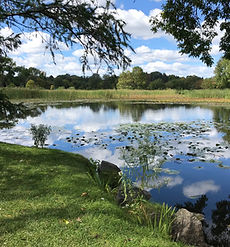
A Violation of Law and Fiore HOA Rules
Feeding wildlife in Florida is generally discouraged and, in some cases, illegal. The Florida Fish and Wildlife Conservation Commission (FWC) strongly advises against feeding wildlife as it can have negative consequences for both animals and humans.
Here are a few key points regarding feeding wildlife in Florida:
Feeding the Wildlife
5 Key Points about
Feeding Wildlife
Instead of feeding wildlife, it is recommended to appreciate them from a distance and respect their natural behaviors. Observing wildlife in their natural habitats can provide educational and enjoyable experiences while minimizing potential negative impacts. If you encounter injured or orphaned wildlife, it is best to contact local wildlife rehabilitation centers or the FWC for guidance on how to assist them appropriately.

Disruption of Natural Behavior
Feeding wildlife disrupts their natural behavior patterns and can lead to dependency on human-provided food. This dependency can alter their foraging habits, affect their ability to find natural food sources, and potentially lead to overpopulation in certain areas.

Wildlife-Human Conflicts
Animals that become accustomed to human-provided food may lose their fear of people and become more aggressive or bold in their behavior. This can pose risks to human safety and result in property damage.

Disease Transmission
Concentrating animals in one area through feeding can increase the risk of disease transmission among them. Sharing food can result in the spread of parasites and pathogens, endangering both wildlife populations and public health.

Legal Implications
In Florida, feeding certain wildlife species, such as bears, alligators, and sandhill cranes, is illegal under state regulations. Violating these laws can result in fines and penalties.

Habitat Alteration
Feeding wildlife often attracts them to areas where they may not naturally occur or concentrate in larger numbers. This can lead to habitat alteration, degradation, and damage to natural ecosystems.

It's hard to resist but...
Don't harm wildlife with your kindness. Help them remain healthy safe and free.

Florida State Statutes, Laws & Penalties

What is a Retention Pond?
About the Fiore Retention Pond
A retention pond, commonly found within a condo complex, is a man-made water feature designed to collect and manage stormwater runoff. It serves as a temporary storage area for excess rainwater, preventing flooding by controlling the flow of water during heavy rainfall events. Retention ponds are typically designed with sloping sides and a basin-like shape to hold water temporarily and allow it to slowly percolate into the ground or be released at a controlled rate. These ponds are often landscaped with vegetation and may include features like sediment traps and drainage systems to filter pollutants and improve water quality.
In addition to their functional purpose, retention ponds can enhance the aesthetic appeal of a condo complex, providing a tranquil environment and potentially attracting wildlife.
If a retention pond becomes excessively polluted, particularly due to wildlife being fed by humans, it can have several negative consequences for the ecosystem and the pond itself. Here are some potential impacts:
Other Uses of Retention Ponds

While it is uncommon, in some cases, a retention pond within a condo complex can be utilized as a water source for outdoor sprinkler systems. This practice is more prevalent in areas where access to freshwater is limited or costly. By using the water stored in the retention pond, condo complexes can conserve potable water resources and reduce their reliance on municipal supplies.
However, it is important to note that the use of retention pond water for irrigation requires appropriate aeration and treatments to ensure the water quality meets the necessary standards for irrigation purposes.
Additionally, the design and management of the retention pond should consider the potential impact on wildlife and the overall ecosystem.
Proper maintenance, including regular inspections, monitoring, and appropriate water level management, is crucial to maintain the functionality and ecological balance of the retention pond while utilizing it for outdoor sprinkler systems.

Impacts about Fiore Retention Pond & the Wildlife
01
Water Quality Degradation:
The pollution caused by wildlife waste and excessive feeding can lead to a decline in water quality within the retention pond. Accumulation of feces and food waste can introduce harmful bacteria, excessive nutrients, and other pollutants into the water. This can result in oxygen depletion, algal blooms, and an imbalance in the ecosystem, leading to poor water quality conditions.
03
Disease Transmission:
Concentrated populations of wildlife, attracted by excessive feeding, can increase the risk of disease transmission. Close proximity and shared food sources can facilitate the spread of pathogens and parasites among wildlife species. This can result in illness, mortality, and potential transmission of diseases to humans or other animals in the surrounding area.
02
Ecosystem Disruption:
Pollution in the retention pond can disrupt the natural balance of the ecosystem. Excessive nutrients from wildlife waste and food can promote the growth of algae and aquatic plants, causing overgrowth and oxygen depletion. This can negatively impact native plant and animal species that rely on the pond for habitat, potentially leading to a decline in biodiversity.
04
Odor and Aesthetic Issues:
A polluted retention pond can emit unpleasant odors. Musty or “rotten egg” odor to your water indicates the presence of hydrogen sulfide due to decomposition of organic matter, excessive algae growth, and stagnant water conditions. This can diminish the aesthetic appeal of the condo complex and create an unpleasant environment for residents and visitors.
Help Protect our Wildlife
To prevent or mitigate these issues, it is important to discourage the feeding of wildlife near retention ponds and implement proper management strategies.
Our retention pond has an increased duck and bird poop problem that is soiling our landscape, grounds and public walkways in addition to polluting the retention pond.
If our fish and turtles are fed they are not eating mosquito larva and natural foods provided by nature.
